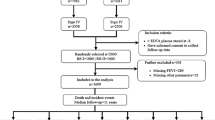Abstract
Cross-sectional analysis from longitudinal studies for a specific age can include subjects who entered the study at different ages (i.e. younger individuals followed to the age of interest, and those who entered at the age of interest). This represents a potential source of bias, since the state of health at a given age may vary based on age at entry. We investigated such bias as it affected the prevalence of cardiovascular diagnoses in men from the Baltimore Longitudinal Study of Aging. Subjects who entered the study in either their 60′s, 70′s or 80′s (New subjects) were compared to individuals who entered the study at an age at least 10 years younger and were followed into these same age decades (Continuing subjects). No differences were found between New and Continuing subjects for coronary heart or cerebrovascular diseases, but were present for hypertension. The greater prevalence of hypertension in Continuing subjects appeared to be of minor clinical importance because other diagnostic differences were absent. The study found evidence for potential selection bias based on age at entry, but the consequence of the bias appeared to be slight. (Aging 3: 355-360, 1991)
Similar content being viewed by others
References
Kleinbaum D.G., Kupper L.L., Morgenstein H.: Epidemiologic Research, Principles and Quantitative Methods. Van Nostrand, Reinhold, New York, 1982.
Setzer C.C., Jablon S.: Effects of selection on mortality. Am. J. Epidemiol 100: 367–372, 1974.
National Center for Health Statistics. Health Statistics on Older Persons, United States, 1986. Department of Health and Human Services, DHHS Publication No. (PHS) 87-1409, 1987.
Hiscock B., Metter E.J., Brant L: Mortality patterns in the Baltimore Longitudinal Study of Aging. Gerontologist 28 (suppl.): 108A, 1988.
Shock N.W., Greulich R.C., Andres R., Arenberg D., Costa P.T. Jr, Lakatta E.G., Tobin J.D.: Normal Human Aging: The Baltimore Longitudinal Study of Aging. U.S. Department of Health and Human Services. NIH Publication No. 84-2450, 1984.
Rose G.A., Blackburn H.: Cardiovascular Survey Methods. WHO Monograph Series No. 56, 1968.
SAS: SAS User’s Guide: Statistics, ed. 5. Cary, North Carolina, SAS Institute, pp. 529-558, 1985.
Schlesselman J.J.: Case-Control Studies, Design, Conduct, Analysis. New York, Oxford, 1982.
Bell B., Rose C.L., Damon A.: The Veterans Administration longitudinal study of healthy aging. Aging and Human Development 3: 3–17, 1972.
Author information
Authors and Affiliations
Rights and permissions
About this article
Cite this article
Jeffrey Metter, E., Fleg, J.L., Brant, L.J. et al. Effect of age of entry to a longitudinal study on cross-sectional determination of cardiovascular disease. Aging Clin Exp Res 3, 355–360 (1991). https://doi.org/10.1007/BF03324036
Received:
Accepted:
Published:
Issue Date:
DOI: https://doi.org/10.1007/BF03324036




